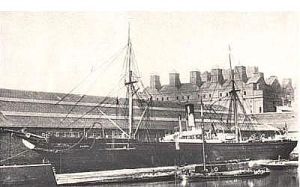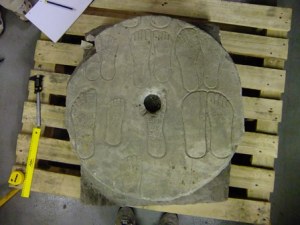Last week, Peter Liddel and I were back at the World Museum, Liverpool, for another bout of research into their Greek inscriptions. On this visit, we weren’t looking at the actual stones, but at the Museum’s archives, to see if we could uncover a bit more information about the origins of the collection. (We were also catching up on the plans to put some of the inscriptions on public display: from this week, you will be able to see the Phrikyladai decree, and some other inscriptions, in the Museum’s Ancient World Gallery . Admission is free, and the cafe is excellent: do visit!)
We (or rather, Dr Gina Muskett, the indefatigable curator of Classical Antiquities at the Museum) have now located thirteen Greek inscriptions in the collection. (We know that there used to be at least one more, but it can no longer be found: it was probably destroyed when the Museum was bombed in World War Two.) The origins of some of these inscriptions are well-documented – particularly those which came from the collections of Henry Blundell, a figure who fits quite neatly the model of a ‘typical’ antiquities collector of the eighteenth and nineteenth centuries. Blundell deployed his (extensive) personal wealth both to fund a ‘Grand Tour’ to Italy, and to purchase (there and elsewhere) significant numbers of Greek and Roman antiquities (as well as more modern work), which he used to adorn his mansion, Ince Blundell.
One of the very interesting features of the Liverpool collection, though, is that it throws light on another route by which ancient antiquities found their way from the Mediterranean to the Mersey. Readers of this blog will (perhaps) remember that one of the Liverpool inscriptions – the decree of the Phrikyladai – came from the collections of the MacIver family, Liverpool ship-owners of the nineteenth century. Another one (IK Ephesos 2269A: a funerary monument for Herodotus), is recorded as having been donated by ‘E. Bibby Esq.’, who seems very likely to be connected to another great Liverpudlian shipping dynasty. But the Museum’s accession registers and guard books reveal that it wasn’t just the ship-owners who were interested in collecting Greek inscriptions, but also their employees, the ships’ captains. We have found records of inscriptions being presented by three such men: Captains Fothergill, McNab, and Ferguson.

Capt. Ferguson’s ship: the ss Aleppo (picture from http://www.clydesite.co.uk)
We don’t (yet) know very much at all about these men, nor about their reasons for collecting these inscriptions. Captain McNab, at least, seems to have stumbled across his specimen by accident (the register records that the inscription which he presented to the Museum in 1885 was ‘dredged up on the fluke of an anchor’). But it seems as if at least one of these sea-captains had a more active interest in epigraphy (or, at any rate, in Greek and Roman antiquities). Working through the archives last week, we discovered that four of the inscriptions in the collection – which are now scattered around the stores, and which we had been treating as quite separate items – all came to the Museum as part of a single gift, and were all donated by one man: Captain John Ferguson, employee of the Cunard Line, and, according to the Liverpool Mercury’s ‘Nautical Jottings’ for 16th July 1892, ‘one of most well-liked commanders of the Cunard fleet’. In the late 1880s, Captain Ferguson sailed to the eastern Mediterranean on the S.S. Aleppo. While passing through Cyzicus (on the south side of the Sea of Marmara – also known as the Propontis), he collected (we don’t know how, or from whom) an excellent epigraphic variety-pack: a small altar; a decorated gravestone; a late-Roman inscription wishing sporting (or other) success for a particular faction at the Circus; and (my favourite) a large slab inscribed with the outlines of pairs of feet, each foot (or pair of feet) recording the name of its owner. In 1890, Ferguson gave all of these to the Museum (together with three other, uninscribed, antiquities, which he had collected on the same voyage).

Inscribed ancient feet from Cyzicus (and some uninscribed modern feet from Manchester), being studied in the World Museum’s stores this summer.
For now, we can only speculate about why Ferguson chose to collect these inscriptions – and why he then chose to give them to the Museum (I won’t expand here on my favoured, and entirely unsupported, hypothesis, which involves an irate Mrs Ferguson, an unfulfilled expectation that a good souvenir from Turkey might be a carpet or some spices rather than a pile of rubble, and a furiously-brandished rolling pin…). We know that Ferguson was elected a Corresponding Member of the Liverpool Literary and Philosophical Society in 1890, the same year as his donation to the Museum, and it’s tempting to see a connection between that honour and this act of epigraphic philanthropy. But we haven’t yet found any evidence for antiquarian activity after 1890 (or indeed before it): in the last stages of his career, Ferguson seems to have been primarily involved in Cunard’s prestigious Atlantic routes. His death in August 1900, at his modest residence in Norma Road, Waterloo (just north of Bootle), was announced in the Liverpool Mercury, but did not warrant an obituary. It is possible, then, that his epigraphic legacy consists only of these four inscriptions, which have been lying unpublished in the Liverpool storerooms for over a century now. If so, that makes us even more pleased to be able to bring them back out of the shadows: working on a proper publication of these four texts (and the other unpublished material in the collection) is one of our next big tasks. Another is to continue to build up our picture of patterns of epigraphic collection, in Liverpool and elsewhere in the UK: this is the focus of our long-term ‘UK Epigraphy’ Project, whose initial results we are collecting on this website. More about that in a future blog!
Tongue-in-cheek, you could see the sea-captains stepping up to the challenge laid down by Michaeils?
See the comments made by Michaelis: after visiting Liverpool’s public museum in 1877, he noted that, while it was then relatively lacking in classical art & antiquities, ‘the multifarious connections of Liverpool trade with the Levant, give promise that the Museum will receive further additions in this department’ (p 423 of Michaelis, A 1882 (trans. C A M Fennell) Ancient Marbles in Great Britain, Cambridge).
I wonder how the names/social classes behind the donations discussed in this blog post relate to some earlier donors of Greek inscriptions to a Liverpool public (-ish) collection? Thinking of the Liverpool (Royal) Institution’s Museum, which got sent two Greek inscriptions from Asia Minor in the 1840s (ie in the Mayer era), supposedly from Xanthus, Lycia (1844, via Institution past-president and lead-shot manufacturer Joseph N Walker [1791-1865]) and Halicarnassus (1849, ex one Samuel Winstanley).
I’d missed that line in Michaelis: nice! (Michaelis saw the feet inscription, actually: the Museum register gives his assessment of it. So perhaps they invited him back to show that they’d listened to his advice…
Whether our captains moved in the same sorts of circles as Walker and Winstanley is something I’m not sure about. It’s pretty plausible, I think, that Ferguson’s employer (MacIver) would (or could) have run into these people (MacIver’s house — Calderstones — was built and originally lived in by Walker, in fact…) — and MacIver himself also donated an inscription to the museum. There’s perhaps also an indirect connection via the Liverpool Lit & Phil (which, as you will know, used the Royal Institution’s building for its meetings). But how actively involved the sea captains were in this part of Liverpool life is something I haven’t yet pinned down.